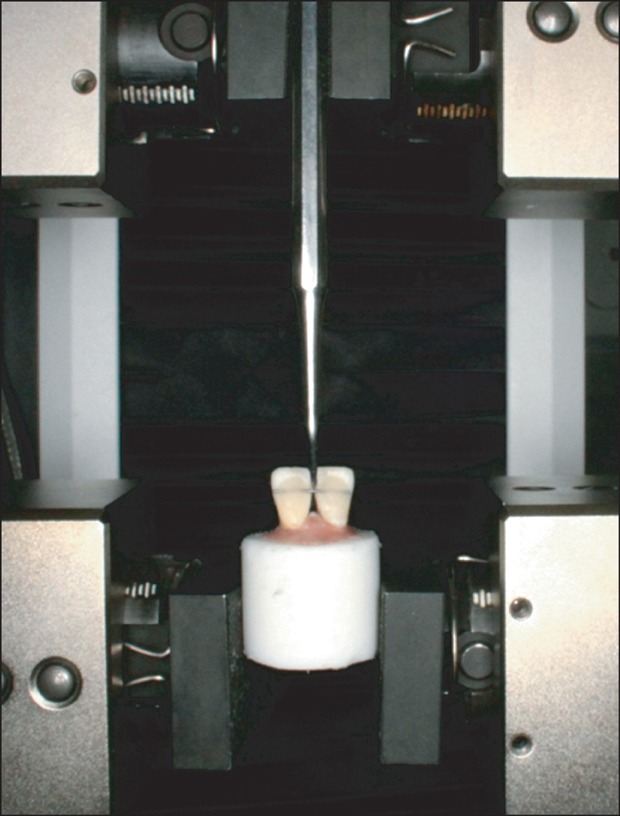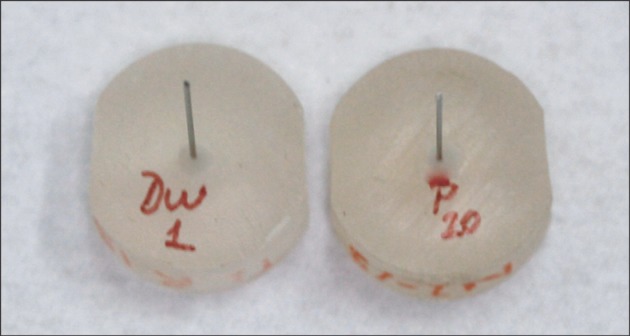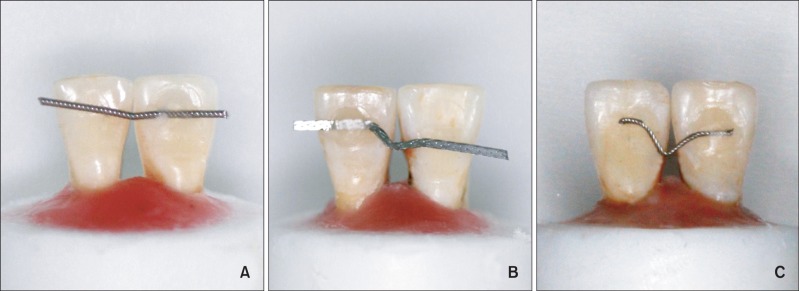Korean J Orthod.
2012 Feb;42(1):39-46.
Comparison of three different orthodontic wires for bonded lingual retainer fabrication
- Affiliations
-
- 1Department of Orthodontics, Faculty of Dentistry, Izmir Katip Celebi University, Izmir, Turkey. baysalasli@hotmail.com
- 2Department of Orthodontics, Faculty of Dentistry, Erciyes University, Kayseri, Turkey.
Abstract
OBJECTIVE
We evaluated the detachment force, amount of deformation, fracture mode, and pull-out force of 3 different wires used for bonded lingual retainer fabrication.
METHODS
We tested 0.0215-inch five-stranded wire (PentaOne, Masel; group I), 0.016 x 0.022-inch dead-soft eight-braided wire (Bond-A-Braid, Reliance; group II), and 0.0195-inch dead-soft coaxial wire (Respond, Ormco; group III). To test detachment force, deformation, and fracture mode, we embedded 94 lower incisor teeth in acrylic blocks in pairs. Retainer wires were bonded to the teeth and vertically directed force was applied to the wire. To test pull-out force, wires were embedded in composite that was placed in a hole at the center of an acrylic block. Tensile force was applied along the long axis of the wire.
RESULTS
Detachment force and mode of fracture were not different between groups. Deformation was significantly higher in groups II and III than in group I (p < 0.001). Mean pull-out force was significantly higher for group I compared to groups II and III (p < 0.001).
CONCLUSIONS
Detachment force and fracture mode were similar for all wires, but greater deformations were seen in dead-soft wires. Wire pull-out force was significantly higher for five-stranded coaxial wire than for the other wires tested. Five-stranded coaxial wires are suggested for use in bonded lingual retainers.
Keyword
Figure
Reference
-
1. Sinclair PM, Little RM. Maturation of untreated normal occlusions. Am J Orthod. 1983; 83:114–123. PMID: 6572039.
Article2. Bishara SE, Treder JE, Damon P, Olsen M. Changes in the dental arches and dentition between 25 and 45 years of age. Angle Orthod. 1996; 66:417–422. PMID: 8974177.3. Little RM, Wallen TR, Riedel RA. Stability and relapse of mandibular anterior alignment-first premolar extraction cases treated by traditional edgewise orthodontics. Am J Orthod. 1981; 80:349–365. PMID: 6945805.
Article4. Parker WS. Retention--retainers may be forever. Am J Orthod Dentofacial Orthop. 1989; 95:505–513. PMID: 2729197.
Article5. Durbin DD. Relapse and the need for permanent fixed retention. J Clin Orthod. 2001; 35:723–727. PMID: 11822294.6. Cerny R. Permanent fixed lingual retention. J Clin Orthod. 2001; 35:728–732. PMID: 11822295.7. Booth FA, Edelman JM, Proffit WR. Twenty-year follow-up of patients with permanently bonded mandibular canine-to-canine retainers. Am J Orthod Dentofacial Orthop. 2008; 133:70–76. PMID: 18174074.
Article8. Dahl EH, Zachrisson BU. Long-term experience with direct-bonded lingual retainers. J Clin Orthod. 1991; 25:619–630. PMID: 1814943.9. Zachrisson BU. The bonded lingual retainer and multiple spacing of anterior teeth. Swed Dent J Suppl. 1982; 15:247–255. PMID: 6963780.10. Bryan DC, Sherriff M. An in vitro comparison between a bonded retainer system and a directly bonded flexible spiral wire retainer. Eur J Orthod. 1995; 17:143–151. PMID: 7781723.
Article11. Bearn DR. Bonded orthodontic retainers: a review. Am J Orthod Dentofacial Orthop. 1995; 108:207–213. PMID: 7625397.
Article12. Cooke ME, Sherriff M. Debonding force and deformation of two multi-stranded lingual retainer wires bonded to incisor enamel: an in vitro study. Eur J Orthod. 2010; 32:741–746. PMID: 20547494.
Article13. Artun J, Urbye KS. The effect of orthodontic treatment on periodontal bone support in patients with advanced loss of marginal periodontium. Am J Orthod Dentofacial Orthop. 1988; 93:143–148. PMID: 3422529.14. Bearn DR, McCabe JF, Gordon PH, Aird JC. Bonded orthodontic retainers: the wire-composite interface. Am J Orthod Dentofacial Orthop. 1997; 111:67–74. PMID: 9009926.
Article15. Lumsden KW, Saidler G, McColl JH. Breakage incidence with direct-bonded lingual retainers. Br J Orthod. 1999; 26:191–194. PMID: 10532157.16. Lie Sam Foek DJ, Ozcan M, Verkerke GJ, Sandham A, Dijkstra PU. Survival of flexible, braided, bonded stainless steel lingual retainers: a historic cohort study. Eur J Orthod. 2008; 30:199–204. PMID: 18222927.
Article17. Artun J, Bergland S. Clinical trials with crystal growth conditioning as an alternative to acid-etch enamel pretreatment. Am J Orthod. 1984; 85:333–340. PMID: 6231863.18. Oliver RG. The effect of different methods of bracket removal on the amount of residual adhesive. Am J Orthod Dentofacial Orthop. 1988; 93:196–200. PMID: 2964197.19. Al Yami EA, Kuijpers-Jagtman AM, van't Hof MA. Stability of orthodontic treatment outcome: follow-up until 10 years postretention. Am J Orthod Dentofacial Orthop. 1999; 115:300–304. PMID: 10066979.
Article20. Aldrees AM, Al-Mutairi TK, Hakami ZW, Al-Malki MM. Bonded orthodontic retainers: a comparison of initial bond strength of different wire-and-composite combinations. J Orofac Orthop. 2010; 71:290–299. PMID: 20676816.
Article21. Zachrisson BU. Long-term experience with direct-bonded retainers: update and clinical advice. J Clin Orthod. 2007; 41:728–737. PMID: 18192755.22. Radlanski RJ, Zain ND. Stability of the bonded lingual wire retainer-a study of the initial bond strength. J Orofac Orthop. 2004; 65:321–335. PMID: 15289924.
Article23. Reynolds IR. A review of direct orthodontic bonding. Br J Orthod. 1975; 2:171–178.
Article
- Full Text Links
- Actions
-
Cited
- CITED
-
- Close
- Share
- Similar articles
-
- A study of shear bond strength of bonded retainer according to the bonding method and type of wires
- Effect of thermocycling on shear bond strength and mode of failure of bonded retainer using flowable composite resin
- Report on a case treated with lingual multibracket appliance
- The study of tension characteristics in orthodontic wires
- Clinical study on the relapse of diastema




